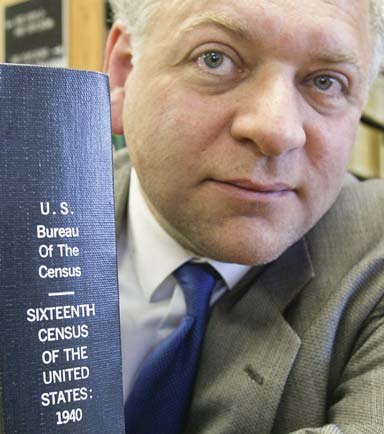New look at old data

Tim Seman, genealogy and local history librarian at the main public library in Youngstown, displays a bound volume of 1940 census results. Seman will lead a Monday workshop on that census at main library on Wick Avenue.
YOUNGSTOWN
Detailed information about Americans, including Mahoning Valley residents, who lived through the Great Depression will be unveiled Monday, after having been sealed for the past 72 years. At 9 a.m. that day, the individual 1940 census forms, which were kept confidential to protect respondents’ privacy, will be released publicly for free by the National Archives at 1940census.archives.gov, providing families with a wealth of genealogical information.
“Many of us have parents who did not appear in a census until the 1940 census, so it will be interesting to see how families were situated in 1940,” said Tim Seman, genealogy and local history librarian at the main library of the Public Library of Youngstown and Mahoning County.
“We had a lot of movement from the South up into the North to work in the mills,” including that of black Americans, who moved here to work in Youngstown’s steel mills, Seman observed.
The 1940 census documented immigration from Europe and migration from farms to cities, such as Youngstown, for purposes of employment, he added.
That census will also pinpoint the last known residences of Japanese- Americans before they were ordered into detention camps during World War II.
The library will observe the release of the census and inspect the results at a free 6:30 p.m. Monday workshop Seman will conduct at the main library, 305 Wick Ave. Reservations may be made by calling 330-744-8636.
“I don’t expect everybody to be able to find the information that they want that night, but they’re going to get a complete introduction on how to obtain it,” he said.
The main library is fortunate to have a comprehensive local history and genealogy collection and skilled librarians, such as Seman, to help patrons use it, said Janet Loew, library communications and public relations director.
“We see every day how important that is in people’s lives,” Loew said. “It’s very important to people to know their roots.”
In 1940, some 120,000 census enumerators conducted face-to face interviews with someone from every household, asking questions about employment or unemployment status, occupation, income, participation in New Deal programs such as the Works Progress Administration, and the respondents’ place of residence five years earlier.
“The enumerators that went out in 1940 were well-prepared for what they were about to do,” Seman said, referring to the census- takers’ training. “They tried to go to every place where they thought somebody was living.
“Some of the details that might be lost in a mail-in [census] could be clarified in an in-person census interview,” he observed.
The 1940 census, which asked 34 questions of every respondent, pegged the U.S. population at 132.2 million and Youngstown’s population at 167,624.
In contrast, the 2010 census, which was conducted by mail and asked only 10 questions of every respondent, employed 635,000 census-takers to visit those who didn’t respond by mail. It pegged the national population at 308.7 million and Youngstown’s population at 66,982.
The 1940 count cost $67.5 million, compared with $12.4 billion for 2010.
In the 1940 census, 91.3 percent of Youngstown’s population was white and 8.7 percent was black. By contrast, the 2010 census showed Youngstown’s population to be 47 percent white and 53 percent black and other minorities.
Of the city’s population over age 25 in 1940, some 33.4 percent had completed seven or eight years of schooling, 14.3 percent completed high school and only 3.9 percent completed four or more years of college. The 2010 census showed 78.8 percent of the city’s respondents over age 25 graduated high school and 10.5 percent had bachelor’s degrees or higher. Some 60.9 percent of respondents owned their own homes and the median annual household income was $24,318.
Some 79.8 percent of the people in the city’s labor force in the 1940 census were employed in work other than public emergency work, such as emergency work being defined as the WPA, National Youth Administration or Civilian Conservation Corps or state or local work relief agencies.
Only 17.8 percent of families reported making $2,500 or more in 1939.
Those searching for an image of the handwritten form filled out by a census-taker concerning a specific family will start by verifying the family’s home address in the library’s microfilmed 1940 Youngstown city directory.
Based on the home address, Seman will refer to a census map, from which he will determine which of the city’s 150 enumeration districts contained that street address and then search for that family by name within that district.
Those who can’t attend Monday’s session may visit the main library’s genealogical reference section for assistance from a librarian any time the library is open.
Volunteers from the Mahoning County Chapter of the Ohio Genealogical Society are available from 1 to 4 p.m. Thursdays to help main library patrons.
Main library is open from 9 a.m. to 9 p.m., Monday through Thursday, and from 9 a.m. to 5:30 p.m. Fridays and Saturdays. It is closed Sundays.
 43
43
